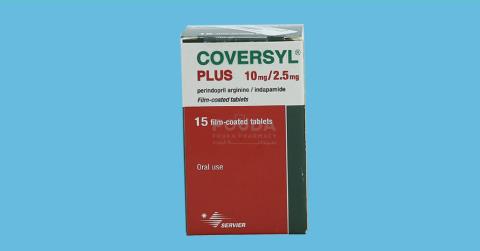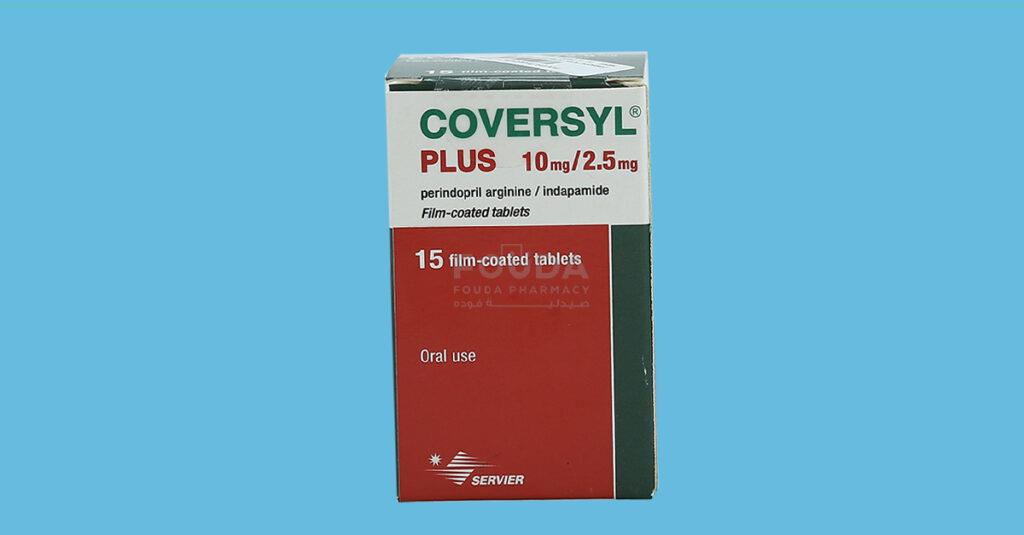Coversyl Plus: uses, uses and things you need to care about

Coversyl Plus is a drug used in the treatment of hypertension. So what are the uses, usage and things to keep in mind when using the drug? The sharing of Master, Pharmacist Truong Van Dat will help you understand the information about this product!
content
- What is Coversyl Plus?
- What is Coversyl Plus used for?
- How much does Coversyl Plus cost?
- Dosage of Coversyl Plus
- How to use Coversyl Plus?
- What to do in case of overdose or missed dose?
- Coversyl Plus side effects
- Things to keep in mind when taking medicine
- Coversyl Plus drug interactions
- How to store Coversyl Plus?
What is Coversyl Plus?
Coversyl Plus is a film-coated tablet containing two active ingredients, the arginine salts of perindopril and indapamide. Drug used to treat hypertension with the ratio of 10mg perindopril arginine and 2.5mg indapamide.
One box contains 1 vial of 30 film-coated tablets.

Coversyl Plus
What is Coversyl Plus used for?
Each active ingredient of the drug has the effect of lowering blood pressure.
When combined, it will help increase activity and reduce side effects when used as monotherapy.
Perindopril belongs to the group of angiotensin-converting enzyme inhibitors (ACEIs).
These drugs work by dilating blood vessels, making it easier for the heart to pump blood through the vessels. Indapamide belongs to the group of thiazide diuretics, which slightly increase the amount of urine filtered by the kidneys.
This drug is indicated for use as alternative therapy in the treatment of hypertension, in patients already receiving similar doses of perindopril and indapamide.
See more: High blood pressure should eat what?
How much does Coversyl Plus cost?
The reference price for 1 bottle of 30 Coversyl Plus tablets with 10mg/2.5mg content is 300 - 350 thousand VND. Retail price is about 9.5 thousand VND/tablet.
However, these prices are for reference only and may change from time to time.
See also: Amlodipine: Uses to lower blood pressure and notes to know
Dosage of Coversyl Plus
Dosage should be adjusted for individual subjects.
- Adults: Take 1 tablet per day, should be taken in the morning, before meals.
- Elderly: May be treated after considering response to blood pressure and renal function. No dose adjustment required.
- Patients with impaired body: Adjust the dose according to the doctor's prescription. It should be combined with regular follow-up visits and periodic monitoring of creatinine and potassium levels. Contraindicated in patients with severe to moderate renal impairment (creatinine clearance less than 60ml/min).
- Hepatic impairment: Contraindicated in patients with severe hepatic impairment. In patients with moderate hepatic impairment, no dose adjustment is necessary.
- Children and adolescents: Coversyl Plus 10mg/2.5mg is not recommended.
How to use Coversyl Plus?
Coversyl Plus should be taken in the morning, before meals and swallowed whole with a glass of water.
It is important to follow the doctor's instructions because sometimes the doctor may decide to adjust the dose in patients with renal impairment. If you have any questions, ask your doctor or pharmacist immediately.
What to do in case of overdose or missed dose?
Treatment of overdose
The most common manifestation of overdose is hypotension. Then the patient will be dizzy, vomiting, cramps, somnolence, mental confusion. More severe patients will have salt and water disturbances, fatigue and fainting. At that time, you need to see a doctor immediately or go to the nearest hospital emergency department immediately.
The commonly used measures are to quickly eliminate the drug from the body through the gastrointestinal tract; bowel lavage and/or oral activated charcoal. Then carry out fluid resuscitation and electrolyte balance until these indicators return to normal.
Handling missed dose
The drug requires regular intake as prescribed by the doctor for better effect. If you miss a dose, take your next dose at the scheduled time. Do not double your dose to make up for the missed dose.
Coversyl Plus side effects
- Swelling of the face, lips, mouth, tongue or throat
- Cough, difficulty breathing
- Low blood pressure , dizziness, headache
- Irregular or fast heart rate
- Tinnitus, cramps, fatigue
- Taste disturbance, sore throat, dry mouth, nausea
- Digestive disorders , diarrhea, constipation
- Hypokalemia
- Allergic reactions ( such as hives)

Coversyl Plus side effects
Things to keep in mind when taking medicine
- The combined use of perindopril and potassium-sparing diuretics is not generally recommended.
- Do not use the drug with certain subjects such as women planning to become pregnant, pregnant women. Use only when absolutely necessary.
- Use with caution in patients with liver and kidney failure.
- Discontinue if hepatic encephalopathy occurs, photosensitivity occurs. If you must use the drug, you should take measures to protect your skin from the sun or under artificial UVA rays.
- Athletes should be aware that this product contains ingredients that could result in a positive doping test.
Coversyl Plus drug interactions
Medications can interact with certain medications, such as:
- Lithium: increases lithium concentrations and increases the risk of lithium toxicity.
- Baclofen: reduces the antihypertensive effect of the drug.
- Non -steroidal anti-inflammatory drugs (including acetylsalicylic acid in high doses): reduce the antihypertensive effect of the drug; increased risk of decreased renal function.
- Imipramine-like antidepressants (tricyclic antidepressants), sedatives: increased risk of excessive hypotension.
- Corticosteroids, tetracosactide: reduce the antihypertensive effect (due to the retention of salt and water by corticosteroids).
- Other antihypertensive agents: Concomitant use of other antihypertensive agents with perindopril/indapamide may cause excessive hypotension.
- Potassium-sparing diuretics (spironolactone, triamterene alone or in combination), potassium supplements (as salts): significantly increase serum potassium concentrations.
- Allopurinol, eytostatic or immunosuppressive agents, synthetic corticosteroids or procainamide: increased risk of leukopenia.
- Anesthesia: increased hypotensive effect. See also: Anesthesia Sevorane
- Diuretics (thiazide or loop diuretics): volume depletion and risk of hypotension. See also: Furosemide diuretics
- Yellow: Nitritoid reactions (symptoms include flushing, nausea, hypotension)
- Hypokalemic agents: amphotericin B (intravenous), glucocorticoids and mineralcorticoids (systemic use), tetracosactide, stimulant enema: Increased risk of hypokalemia.
- Cardiac glycosides: increased toxicity of cardiac glycosides.
- Metformin: causes lactic acidosis.
- Contrast containing iodine: risk of acute renal failure
- Calcium (salt): increased risk of calcium.
- Ciclosporin: risk of increased creatinine.
How to store Coversyl Plus?
Store in a cool dry place below 30°C.
Keep out of reach and sight of children.
Above is the most basic information to care about Coversyl Plus drug . Hope this article will help you to use medicine safely and effectively.